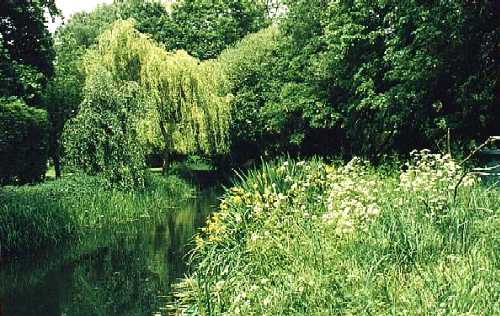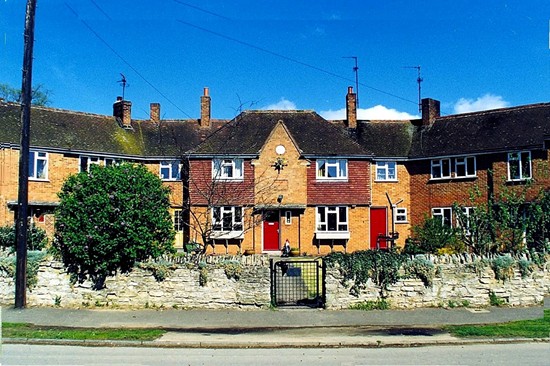|
Greatford
There are three pronunciations for the name Greatford. The older inhabitants call it Gritford, the rest of the village call it Gretford while visitors invariably say Greatford, as it is spelt. Both local pronunciations appear to be correct because Greatford appears in the Domesday book of 1086 as Griteford and Greteford, the meaning of the name being the grit or gravel ford on the West Glen River. Gretford is still found in the school records until 1900. So often when visiting a church, one finds very little information about the saint to whom it is dedicated but this is not so at Greatford. The first thing to be seen on entering is the last scene in the life of the patron saint, Thomas à Becket (1118-1170), English saint and martyr and one-time Archbishop of Canterbury. The picture was painted by a former rector of the parish, the Rev R Burman, and shows Thomas standing in front of the high altar in Canterbury Cathedral facing his four murderers sent by Henry II. Mr Burman studied the life of Thomas for several years and in 1959, while holidaying in Maidenhead, painted this picture, 48 inches X 29 inches, and framed it in local oak as a visual aid or label for the church, there being no other indication of the dedication. It was hung by the rector on All Saints' Day, 29th December 1959.
Presenting the bell to Greatford, Captain H Murray-Clark told the congregation: "HMS Greatford was a small warship and in this it had at once an affinity with this small village after which she was named. The smallness in size of a ship or a community is no measure of the service which they give their Queen and country and although the ship's service in the Royal Navy was not a long one, be assured that it was faithful. Much value is placed by the navy on close links with the varied communities with which they have associations and it is both pleasant and fitting that a part of this ship should come to safe keeping here as a permanent token of this link."
The West Glen River runs through the village and was originally crossed by a ford which disappeared in 1837 when the waterway was bridged and a new road constructed to the north. Records of the locality for the last 100 years show that the village has suffered frequently from flooding with two feet of water in the post office and beer barrels floating in the cellar of the Hare and Hounds public house. But the sight of the river in full flood sending water rushing down the main street is now an unlikely occurrence because the water levels are maintained by electrically controlled sluice gates installed between 1955 and 1957. The Greatford Cut was also dug across country to the River Welland at Market Deeping, a shallow and embanked channel varying from 16 to 24 feet in width and designed to take discharge water from the river in times of flood which in the past has inundated large tracts of arable land in the locality. This is a most attractive spot and my photograph above, taken in February 2001, shows that winter fails to dull the landscape here at Greatford Sluice where there is almost as much green on a February morning as there is in springtime. A big farming tragedy occurred in Greatford on 21st October 1892 in which four people lost their lives when the first floor of a granary where they were working fell through. The accident occurred on the farm owned by Messrs J H and A Dean where the four men were winnowing barley, separating the grain from the chaff. Part of the barn floor above them gave way and the immense weight of the grain fell through, crushing them to death. Those who lost their lives were Ambrose Cooke of Langtoft and his 19-year-old son John, Charles Charity, aged 49, and Kate Arden (or Harding), aged 21, both of Greatford. A twelve-year-old boy, Robert Curtis, who was working in the upper storey shovelling barley down the chute to the workers below, fell with the grain but miraculously escaped injury. An inquest jury subsequently returned a verdict of accidental death and subscriptions were opened in Langtoft and Greatford to assist the families of the deceased who are buried in the churchyard. The tragedy aroused so much interest that a poem written by Mrs Edith Joy, wife of the Rector of Greatford, the Rev Henry Joy, was printed in a leaflet with a black border and distributed throughout the locality. It read:
The original room of the village school at Greatford was built in 1761, according to an inscription on the adjoining school house, and was probably a barn. It was extended in 1874 and in 1904, provisions were made for the admission of children from Barholm and Braceborough. Until 1958, this was an all-age school but senior pupils were then sent to the new secondary modern school at Deeping St James. The village school subsequently closed in 1976. The school was particularly prone to flooding by the West Glen River during times of inclement weather and during the previous 100 years before its closure, pupils were sent home three times before the waters rose and threatened their classrooms. The village hall has been the centre of community activities for almost a century after being given to Greatford in 1913 by Lady Kesteven but major restoration work costing £100,000 is now required and fund-raising is underway to raise the necessary finance to ensure that this popular amenity remains in use. In the autumn of 2003, Greatford was named as one of Lincolnshire's Best Kept Villages after coming top out of 123 entries in the category for villages with a population of 100-500. The competition, organised by the Council for the Protection of Rural England (CPRE), was founded 40 years before and the parish council received a framed certificate to mark their success.
See also REVISED MARCH 2015
Go to: Main Index Villages Index |








